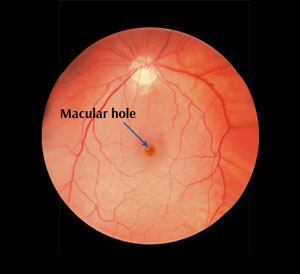66 Pacific Hwy
ST LEONARDS NSW 2065
Fax: 02-8412 0060

The retina is the inside layer of the eye. The macula, which is a specialised central area of the retina, is the part of the eye which sees the clearest detail. The macula is positioned flat against the back of the eye. A macular hole is an irregular opening at the centre of the macula that forms over a period of several weeks to months.
A macular hole is mostly found in elderly people. Within the eye is a transparent jelly (vitreous gel), which fills the main cavity behind the lens in the eye. This jelly pulls on the thin tissue of the macula until it tears and gradually enlarges to form a round hole. A macular hole caused by injury and long term swelling of the macula is less common. There are also no medical problems known to cause macular holes.
The first symptoms of a macular hole are blurred and distorted vision. If the macular hole progresses and becomes wider, a blind spot develops in the central vision. Side vision usually is not affected by a macular hole and it is rather uncommon that a macular hole occurs in both eyes.
Special instruments are used to diagnose a macular hole by your ophthalmologist. In addition some special photographic dye tests might have to be done to determine the extent of the damage of the macula.
To repair and possibly improve vision, vitrectomy surgery is the only treatment. During this surgery your ophthalmologist uses small instruments to remove the transparent jelly that pulls on the macula. The jelly is then replaced by a special gas bubble which will slowly dissolve. To keep the gas bubble in contact with the macula the patient must maintain a constant face down position for one to two weeks. A successful visual result depends a lot on how well this position is maintained as well as on how long the hole was present prior to surgery. Unfortunately, neither medication nor laser surgery is beneficial and vision does not return all the way back to normal, although it usually improves considerably. If central vision is affected in both eyes, low vision devices may help people handle their daily activities. However, vitrectomy surgery includes
some risks which are:
Surgery is not necessary for every individual who has a macular hole. If the vision is normal in the other eye, some people may not be troubled enough to want surgery.
As referred to above, a gas bubble is placed inside the eye in macula hole surgery in order to allow the macula hole on the retina to close. The bubble is necessary as it prevents any fluid from causing the hole to remain open. The macula hole is at the back of the eye, therefore, the patient must posture face down to allow the gas bubble to float up against the macula hole and keep water away from it. This is a difficult position for many people to adopt for a long period of time and unless patients consider this issue before the macula hole operation and agree to comply with this posturing the macula hole operation success rates drop from about 90% down to around 60%.
The posture is difficult to maintain for 24 hours/day therefore, patients may sit up and tilt their head forward with their chin on their chest. This allows reading of a book or magazine. Also, if the patient uses a high seat and puts a television on the floor the patient could watch television.
Similarly at night time it is impossible to lie face down, but if the patient snuggles the cheek onto the side of the pillow the head is in a slightly face down position and this is good enough. The other tricks include sewing a tennis ball onto the back of the pyjama shirt so that the patient does not roll over onto the back during sleep. To allow patients to have some mobility to eat meals and go to the bathroom, ten minutes off per hour is allowed from this posturing regime. The truth of the matter is that some patients simply cannot comply as well as others with such a demand. For this reason, a slightly higher concentration of gas can be injected into the eye. This provides a much larger bubble which keeps water away from the macula hole even if the posturing is not adhered to strictly. However, the down-side of this higher concentration of gas is that the eye pressure needs to be monitored closely, as sometimes the pressure can rise causing eye pain if higher concentrations of gas are used.
Finally, because the macula hole surgery involves injection of a special tissue glue made from the patients own platelets (the clotting cells in the blood stream) the very first 24 hours after the operation should in fact be spent with the face up rather than face down. Only after the first 24 hours should the face down posturing be adopted. To summarise, after macula hole surgery patients should adopt a face-up posture for the first 24 hours, and then adhere to a face-down posture for the next ten days, having ten minutes off per hour. However, up to 60% of macula hole surgeries will still be successful if the posturing is not adhered to strictly.
It is very important not to fly in an aeroplane or travel up to high altitudes until the gas bubble in your eye is gone as this can cause a dangerous rise in eye pressure!














